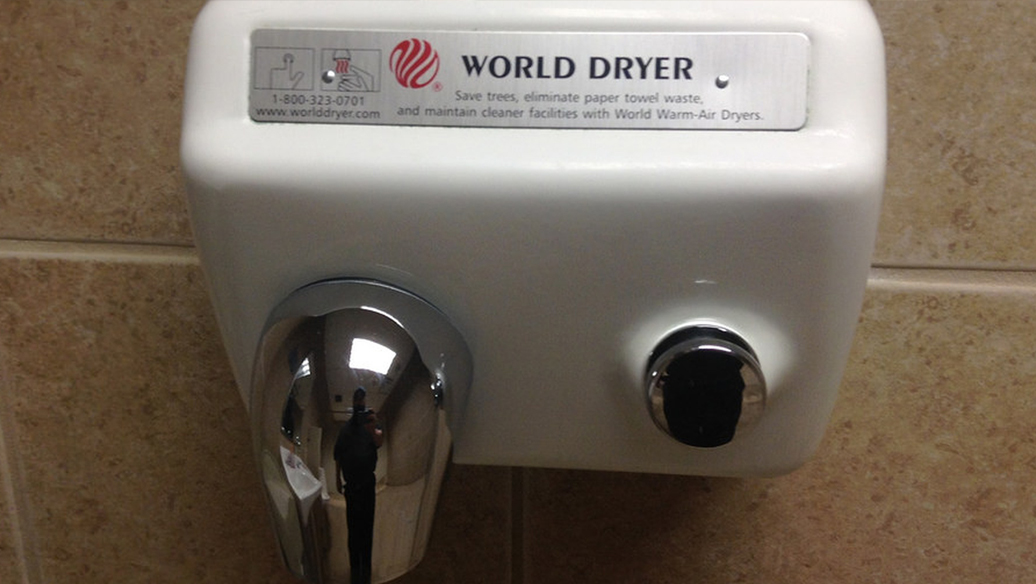[tm_pb_section admin_label=”section”][tm_pb_row admin_label=”Row”][tm_pb_column type=”4_4″][tm_pb_divider admin_label=”Divider” color=”#ffffff” show_divider=”off” height=”50″ height_last_edited=”on|phone” divider_style=”solid”] [/tm_pb_divider][tm_pb_text admin_label=”Text” text_orientation=”justified” use_border_color=”off” border_color=”#ffffff” border_style=”solid”]
Washing your grubby mitts is one of the all-time best ways to cut your chances of getting sick and spreading harmful germs to others. But using the hot-air dryers common in bathrooms can undo that handy hygienic work.
Hot-air dryers suck in bacteria and hardy bacterial spores loitering in the bathroom—perhaps launched into the air by whooshing toilet flushes—and fire them directly at your freshly cleaned hands, according to a study published in the April issue of Applied and Environmental Microbiology. The authors of the study, led by researchers at the University of Connecticut, found that adding HEPA filters to the dryers can reduce germ-spewing four-fold. However, the data hints that places like infectious disease research facilities and healthcare settings may just want to ditch the dryers and turn to trusty towels.
Indeed, in the wake of the blustery study—which took place in research facility bathrooms around UConn—”paper towel dispensers have recently been added to all 36 bathrooms in basic science research areas in the UConn School of Medicine surveyed in the current study,” the authors note.
The research findings largely square with other data showing that hot-air dryers and jet dryers can launch and disperse germs from hands into the air and onto surfaces—essentially setting off a very dirty bathroom bomb. But the new study clearly demonstrates that the less powerful hot-air dryers can also bathe hands with germs already swirling in the wash room.
The researchers speculated that “one reason hand dryers may disperse so many bacteria is the large amount of air that passes through hand dryers, 19,000 linear feet/min at the nozzle. The convection generated by high airflow below the hand dryer nozzles could also draw in room air.”
Commode commotion
The researchers landed on that speculation by first placing plates of gelled bacteria food (agar media plates) in some of UConn’s bathrooms—either for two minutes without hot-air dryers blowing or blasting them with dryer air for 30 seconds while they were 12 inches from the nozzle. If bacteria landed on the plates, they’d begin to grow tiny, domed colonies, which researchers can then count.
In the still bathrooms, the researchers caught an average of zero to one bacterial landings per plate. When they left the plates open for 18 hours, that average leapt to six colonies per plate. But in the line of fire from the blowers for 30 seconds, the plates collected averages from 18 to 60, with a range as high as 254 depending on the bathroom.
The researchers concluded that those launched germs were originating from around the bathroom—not the air dryer nozzles themselves. They deduced this because the bacterial splatter could be replicated by placing tiny, sterile fans around the bathrooms (after accounting for rates of air flow and exposure times). Retrofitting the dryers with HEPA filters reduced the germ count about four-fold.
A unique ripple in the study was that the bathrooms were in the vicinity of a lab studying the harmless spore-forming bacterium Bacillus subtilis strain PS533. Though B. subtilis is a common environmental bug, this lab strain has a distinctive resistance to the antibiotic kanamycin. The researchers could easily pick it out of their bathroom samples by simply growing collected toilet germs in the presence of kanamycin—the survivors were likely PS533 and confirmed by further testing. The researchers ended up finding PS533 milling about in all the bathrooms tested—even the ones in different buildings from the lab.
Brutal blowout
Perhaps most concerning, the researchers found that the air dryers were spreading the spores of PS533. They tested this by exposing their potty germ collections to heat—which will kill growing bacteria and germinated spores but not the spores themselves—then seeing if any spores grew. They did. The researchers then found that the hand dryers were spewing spores onto the surfaces of the bathroom.
PS533 “was almost certainly dispersed throughout bathrooms in the research areas as spores, which would easily survive desiccation in room air, as well as the elevated temperatures in hand dryer air; however, growing or stationary-phase bacteria would not be nearly so hardy as spores,” the authors note. “However, the facile dispersion of one bacterial strain throughout a research facility should probably be a concern to risk assessors and risk managers when dispersion of potentially pathogenic bacteria is considered.” In a final test, the researchers did a cursory look at some of the other bacteria the dryers were blowing around. They found that with or without a HEPA filter, the blowers stirred up potential pathogens, including Staphylococcus aureus.
The findings should be a wake-up call to managers of research and clinical settings. The authors note that Clostridium difficile—a devastating and intractable diarrheal plague—also forms spores, and researchers have found that a flushing toilet can easily launch it into the air.
“This suggests another means of C. difficile transmission and one that may not be interrupted by either hand washing or traditional surface decontamination methods,” the authors conclude. “The role of this potential mode of C. difficile transmission is worthy of future study.”
Source: Ars Technica
[/tm_pb_text][/tm_pb_column][/tm_pb_row][tm_pb_row admin_label=”row”][tm_pb_column type=”4_4″][tm_pb_divider admin_label=”Divider” color=”#ffffff” show_divider=”off” height=”20″ height_last_edited=”on|phone” divider_style=”solid”] [/tm_pb_divider][/tm_pb_column][/tm_pb_row][/tm_pb_section]

